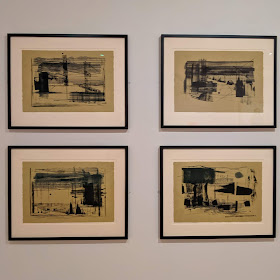 |
| Three of our American Impressionism paintings, including Girl Playing Solitaire (right). |
Additionally, I helped unite on one wall three portraits depicting elite cosmopolitan women, particularly Frank Weston Benson’s angelic figure in Girl Playing Solitaire (1909). Each portrait significantly captures the diverse ways American Impressionists romanticized modern, feminine beauty of the twentieth century. After finalizing the preferred gallery mockup with curatorial staff, I crafted corresponding labels for each artwork, along with one larger wall text to provide context, and so helped curate a cohesive, streamlined display of American Impressionism that joins together modernist works. As a result, visitors entering the gallery are welcomed with a balanced arrangement of canvases that seamlessly transition from radiant portraits of young women in white to uncanny Surrealism.
As the curatorial staff brainstormed display ideas, we focused on exhibiting key works that not only aesthetically and chronologically complemented each other on the walls, but also promoted inclusivity and diversity in WAM’s collection. Cecilia Beaux’s Helen Bigelow Merriman (1908) – one of the Museum’s few paintings by Gilded Age female artists – resided in storage for years. Furthermore, Beauford Delaney’s Portrait of Gaylord (1944) and Sir Jacob Lawrence’s The Checker Players (1947) were chosen to highlight the cultural impact of African-American artists, writers, and musicians on New York City’s Harlem Renaissance. We believed these works deserved more gallery representation.
 |
| Paintings in the Donnelly Gallery, including City Interior (center). |
Other museum staff members made significant contributions to the gallery refresh. Credit goes to WAM’s Director of Education and Experience Marnie Weir for editing rough drafts of labels by curatorial staff. Her guidance helped us refine our language and create relevant content that would boost audience engagement with the art. Rita Albertson, WAM’s George H. and Sybil F. Fuller Term Chair in Conservation and Chief Conservator, provided information on each painting’s condition and frame, some of which were incorporated into labels for American Impressionism. The registrar and exhibition design teams, led by Chief Registrar Gareth Salway and Exhibition Designer and Chief Preparator Patrick Brown, pulled off a variety of tasks: these involved moving artworks to and from storage, mounting wall vinyl, and supervising over the beautification of the gallery, which was repainted white for an updated, spacious look. Art handlers Wes Small and Trevor Toney diligently worked behind-the-scenes to ensure the initial preparation of the gallery went smoothly. These aesthetic improvements show that curators aren’t the only people involved in the setup of museum exhibitions—it truly takes a village!
Through each individual’s efforts, the new display successfully weaves together multiple perspectives—those of expatriates, women, and people of color. Cross-cultural influences abound throughout the gallery, with the wall text narrating how American and European artists spread their ideas. As a result, hidden connections between Impressionism and Modernism are revealed. One could even argue that Childe Hassam’s The Breakfast Room, Winter Morning, New York (1911), while featuring an ideal modern woman as the subject, reflects the rise in early twentieth-century urbanization, a major theme in Charles Sheeler’s City Interior (1936), which looks across from Hassam. Despite embodying distinct styles and interpretations of modernity, each painting in the gallery speaks to the other.** By bridging the gap between Impressionism and Modernism for contemporary audiences, the re-installed Donnelly Gallery fulfills WAM’s core mission of “connecting people, communities and cultures through the experience of art.”
Elizabeth Fox
Curatorial Assistant
American Art Department
September 26, 2019
*Olivia's article, titled "Celebrating Modernity in the Donnelly Gallery," can be found in the most recent issue of access magazine.
**Ironically, Charles Sheeler studied drawing and painting under the American Impressionist William Merritt Chase at the Pennsylvania Academy of the Fine Arts (1903-6).
















